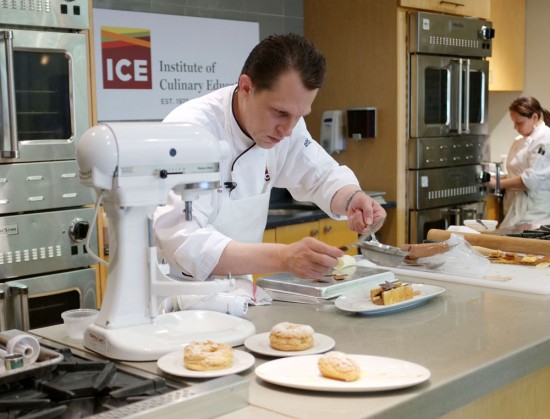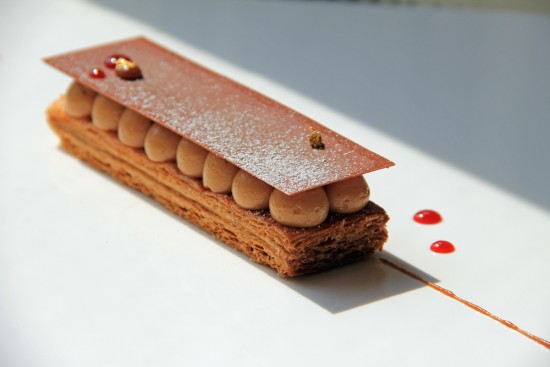After learning the fundamentals of cooking and acquiring a firm grasp of technique, it is our instinct as chefs—and often, a professional requirement—to develop variations on the most iconic dishes in the culinary canon. In truth, even the dishes we create “from scratch” seldom evolve in a vacuum; it is often the reinvention of a well-established dish that provides the best template for personal expression.
Even when our interpretations of codified dishes evolve into something truly unique, the greatest reward of recreating the classics is often rediscovering what made them great in the first place.
Among the many staples of fine pastry, I’ve been obsessed with pâté à choux off and on for several years. Even after years of experimentation, I feel there is much more to harness from this understated preparation and more to refine. When done well, there are few better pastry-based vehicles. But therein lies the problem: often viewed as “just a vehicle” for whatever is inside of it, choux pastry rarely gets the attention it deserves.
No matter the variation, the basic ratio of ingredients in pâté à choux doesn’t vary all that much—and, in fact, hasn’t strayed from the technique developed by Carême (1784-1833), who is regarded as the author of the modern recipe we use today. Given that the standard formula of liquid, fat, flour and eggs is fairly constant, I get the impression that few chefs ever adapt beyond the first version of the recipe they acquire as a student or young cook. That’s a shame, because there is quite a bit that can be discovered and understood by making subtle tweaks to fine-tune the recipe and raise the bar for choux.
Small adjustments in milk fat and nonfat solids can alter the texture, flavor and color of choux dough. Sugars—and sometimes salt—can be omitted outright. And varying the choice of flour, from cake to bread, provides small adjustments in the overall protein content that can significantly affect the final structure and exterior appearance of choux pastries. Last but not least, the time and temperature of the preparation matters at each step: how long to cook the roux, at what temperature should the eggs be added and so forth.
For me, a huge revelation came with developing a technique for applying a crunchy exterior to the finished piece. This textured surface is a sablée of sorts, but closer in proportions to a streusel—roughly equal parts of fat, sugar and flour—that is tender enough to expand with the choux, where a conventional dough would set too quickly and restrict the pastry’s puff. Curiously and counterintuitively, I found that the sablée-draped choux rises up to twice as much as an uncovered one; in short, the sablée slows the drying and setting of the choux surface, allowing it to expand that much more.
Beyond playing with the technical elements, it’s interesting to explore the emotional connection we have with classic desserts—especially how feelings of nostalgia can inspire personal revision. Case in point: the tres leches–inspired dessert that I developed several years ago for Le Bernardin’s dessert menu. This dish was born in conversation with Jesus, one our youngest cooks in the pastry kitchen at the time.
On the surface, it was an exercise and a challenge that I had posed to the team: how do we refine and transform a rather pedestrian dessert into something worthy of a four-star restaurant? What new techniques can we apply to the original concept? Once manipulated, how do we maintain that reference back to the classic, with—or, preferably, without—an overblown sense of irony? So before we did anything new, our team dedicated ourselves to making the best version of the original dessert, without any bells or whistles.
As we tucked into the wet, spongy tres leches, I asked Jesus how it made him feel. Born and raised in the Bronx, he made frequent visits to his grandmother in Mexico as a child. It took a lot of coaxing, but Jesus shyly began to describe many memories connected to the tres leches his grandmother would buy from the bakery in her small town. He remembered her plates and sitting at her kitchen table.
Visiting the shop itself was part of the ritual, and he began to recall the sweet smells and even the color of the shop’s walls. "That," I said, "is what we're trying to do!" No matter how much we add our clever contemporary spin, through technique or ingredients, that nostalgia is what we, as chefs, should be trying to access when creating any dessert. No matter the age of our guests, whether six years old or sixty, the potential in tapping those memories can be incredibly powerful.

This philosophy, however, begs the question, “How do we approach classic desserts that we did not grow up with?” For example, I recently applied the same thought process to rupjmaizes kārtojums, a Latvian dessert that I neither grew up with nor had any professional reference point for. Traditionally a kind of rye bread trifle composed of cream and berries, I reworked the basic flavors and textures of this rustic dish to create a highbrow nudge toward inventiveness and presentation, while still nodding to its homespun origins. Conceptually, the dessert came full circle for me: through its interplay of new and old I realized that one person’s nostalgia can be an opportunity for discovery of another. Most importantly, I was committed to not varying the dish so dramatically from the classic idea as to render it unrecognizable. In fact, I even prepared my version for a group of chefs in Latvia to positive reviews!

Creative reinvention isn’t limited to highly refined plated desserts; I just as frequently seek inspiration from the candy aisle. I’ve been spending a lot of time reworking caramels of late, adjusting recipes and cooking methods to find just the right textures and flavors.
Here, technology has propelled the possibilities for creation. With the small batch vacuum cooker installed in the ICE Chocolate Lab, I have been experimenting with caramels that have no caramel flavor at all. Cooking under a vacuum, we achieve the hallmark textures of a soft caramel at temperatures far below the Maillard reactions, which result in that characteristic caramel flavor.
Instead, I have created a neutral “white” caramel base upon which I can build other flavors that might otherwise be obscured. To this blank canvas I’ve been adding bright fruit flavors like raspberry, peach and apricot—impossible without the aid of technology and a grasp of the underlying confectionery science. Improving on the classics can be a tricky business; it’s easy to stray and lose sight of what makes them great in the first place. Ultimately, the true value of the creative urge to deconstruct is in finding a path towards thoughtful reconstruction.
Click here to learn more about ICE's professional pastry program. Visit our Advanced Pastry Studies page to learn about continuing education classes with Chef Michael.




